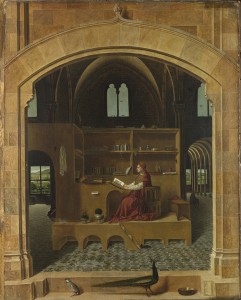![Pisanello<br /><i>Medal of Pier Candido Decembrio</i>, 1448<br />Bust of Pier Candido Decembrio, right, wearing mortier and robe [obverse]<br />On a rocky mount, an open book, with ties and markers [reverse]<br />Lead, diameter 8.1 cm<br />British Museum, London<br />© Trustees of the British Museum](http://italianrenaissanceresources.com/wp-content/uploads/2013/03/3301-1.jpg)
Pisanello
Medal of Pier Candido Decembrio, 1448
Bust of Pier Candido Decembrio, right, wearing mortier and robe [obverse]
On a rocky mount, an open book, with ties and markers [reverse]
Lead, diameter 8.1 cm
British Museum, London
© Trustees of the British Museum
2) As Alberti and other Renaissance intellectuals knew, visual artifacts were important transmitters of complex ideas. Based on that notion, what are some of the reasons a Renaissance collector such as Marcantonio Michiel (discussed in the unit essay) would be interested in restoring fragmentary antique pieces?

Antonello da Messina
Saint Jerome in his Study, about 1475
Oil on lime, 45.7 x 36.2 cm (18 x 14 3/10 in.)
The National Gallery, London
© National Gallery, London/Art Resource, NY
3) This carefully constructed painting shows an image of an ecclesiastic who presents himself as Saint Jerome. Describe the setting and the objects included. What evidence is there to be found in the painting to indicate that the individual depicted is a religious figure and not a secular scholar? What are some possible reasons the patron would want himself to be depicted as Saint Jerome?
4) In the Renaissance, as discussed in the unit essay, individuals associated themselves with books as a way of demonstrating their learning and status. What are some of the objects with which men and women of today associate themselves to indicate their special qualities?